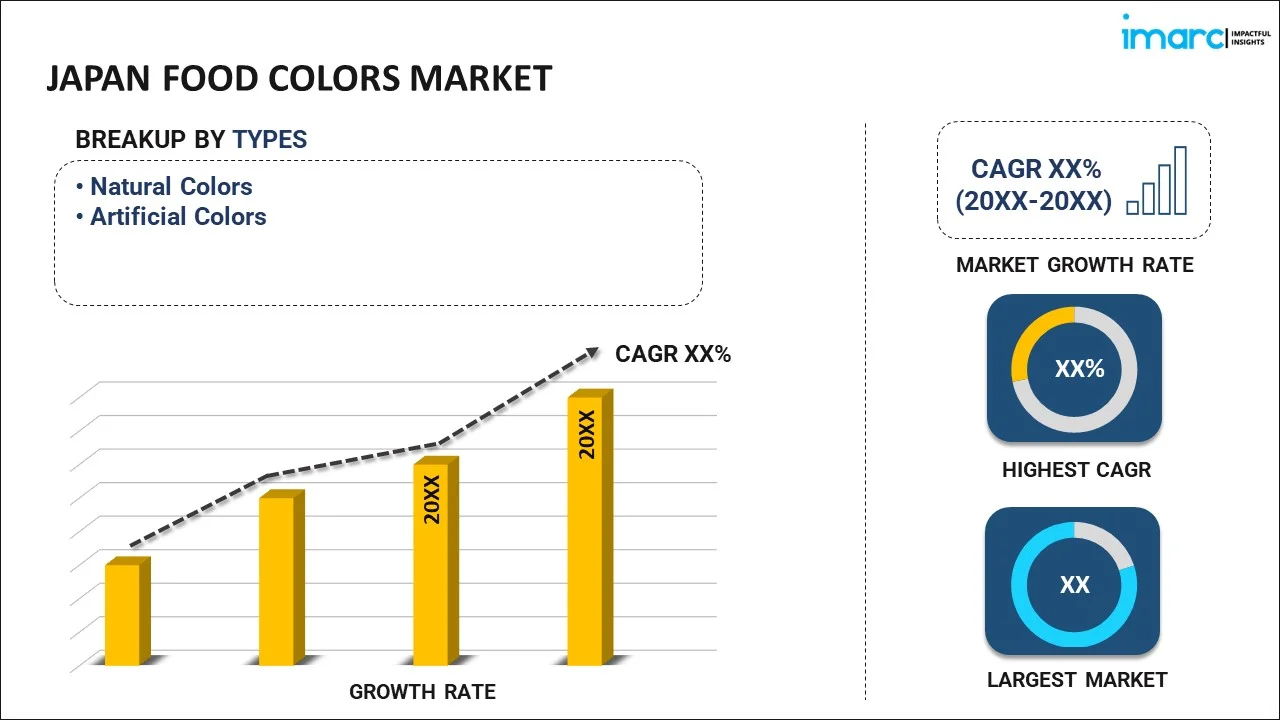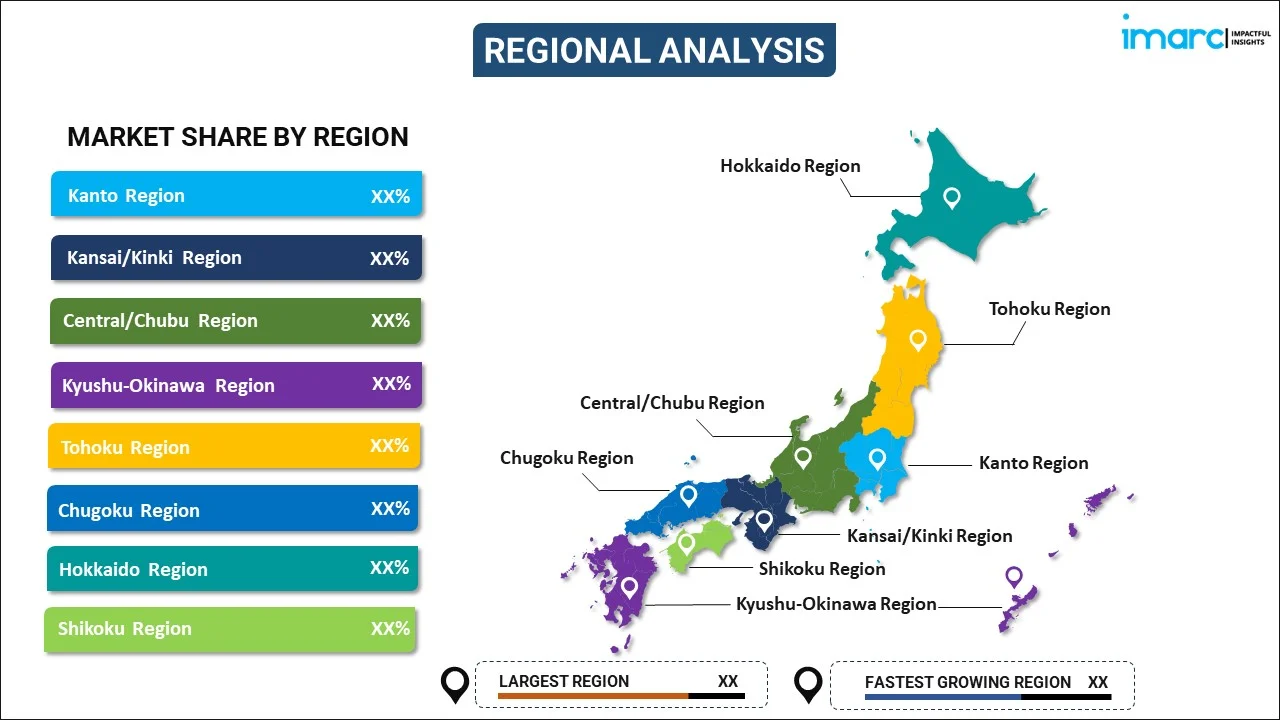
Japan Food Colors Market Report by Type (Natural Colors, Artificial Colors), Form (Liquid, Powder, Gel), Solubility (Dyes, Lakes), Application (Beverages, Meat Products, Dairy Products, Bakery and Confectionary, Processed Food and Vegetables, Oils and Fats, and Others), and Region 2025-2033
Market Overview:
Japan food colors market size reached USD 244.1 Million in 2024. Looking forward, IMARC Group expects the market to reach USD 398.6 Million by 2033, exhibiting a growth rate (CAGR) of 5.1% during 2025-2033. The expanding food and beverage industry, including the bakery, confectionery, and beverage sectors, which creates a steady demand for food colors to enhance the appearance and appeal of products, is driving the market.
|
Report Attribute
|
Key Statistics
|
|---|---|
|
Base Year
|
2024 |
|
Forecast Years
|
2025-2033
|
|
Historical Years
|
2019-2024
|
| Market Size in 2024 | USD 244.1 Million |
| Market Forecast in 2033 | USD 398.6 Million |
| Market Growth Rate (2025-2033) | 5.1% |
Food colors, also known as food dyes or food additives, are substances used to enhance the appearance of food and beverages. They play a crucial role in making foods visually appealing by imparting vibrant and attractive hues. Food colors can be either natural or synthetic. Natural food colors are derived from plant, animal, or mineral sources. Common examples include beetroot extract (red), turmeric (yellow), and spirulina (blue-green). These natural sources are preferred by many consumers due to their perceived safety and health benefits. Synthetic food colors, on the other hand, are chemically synthesized compounds designed to mimic natural colors. They are often used in processed foods and beverages to achieve specific shades that may be challenging to obtain naturally. Food colors are widely used in the food industry to make products more visually appealing, increase consumer acceptance, and differentiate between various flavors or varieties.
Japan Food Colors Market Trends:
The food colors market in Japan is experiencing robust growth, primarily driven by several key factors. Firstly, the increasing consumer demand for visually appealing and appetizing food products is a significant driver. Consumers are drawn to vibrant and enticing colors in their food, as it enhances the overall dining experience. Moreover, the growing awareness of the link between food presentation and perception of taste has fueled the demand for food colors. Additionally, the food industry's constant innovation and product development efforts have spurred the adoption of food colors. Manufacturers are keen on creating unique and attractive products to stand out in a highly competitive market, leading to a consistent demand for food coloring agents. Furthermore, the regional trend towards natural and clean-label ingredients that is pushing manufacturers to develop and incorporate natural colorants derived from fruits, vegetables, and other plant sources is expected to drive the food colors market in Japan during the forecast period.
Japan Food Colors Market Segmentation:
IMARC Group provides an analysis of the key trends in each segment of the market, along with forecasts at the country level for 2025-2033. Our report has categorized the market based on type, form, solubility, and application.
Type Insights:

- Natural Colors
- Artificial Colors
The report has provided a detailed breakup and analysis of the market based on the type. This includes natural colors and artificial colors.
Form Insights:
- Liquid
- Powder
- Gel
A detailed breakup and analysis of the market based on the form have also been provided in the report. This includes liquid, powder, and gel.
Solubility Insights:
- Dyes
- Lakes
The report has provided a detailed breakup and analysis of the market based on solubility. This includes dyes and lakes.
Application Insights:
- Beverages
- Meat Products
- Dairy Products
- Bakery and Confectionary
- Processed Food and Vegetables
- Oils and Fats
- Others
A detailed breakup and analysis of the market based on the application have also been provided in the report. This includes beverages, meat products, dairy products, bakery and confectionary, processed food and vegetables, oils and fats, and others.
Regional Insights:

- Kanto Region
- Kansai/Kinki Region
- Central/ Chubu Region
- Kyushu-Okinawa Region
- Tohoku Region
- Chugoku Region
- Hokkaido Region
- Shikoku Region
The report has also provided a comprehensive analysis of all the major regional markets, which include Kanto Region, Kansai/Kinki Region, Central/ Chubu Region, Kyushu-Okinawa Region, Tohoku Region, Chugoku Region, Hokkaido Region, and Shikoku Region.
Competitive Landscape:
The market research report has also provided a comprehensive analysis of the competitive landscape in the market. Competitive analysis such as market structure, key player positioning, top winning strategies, competitive dashboard, and company evaluation quadrant has been covered in the report. Also, detailed profiles of all major companies have been provided.
Japan Food Colors Market Report Coverage:
| Report Features | Details |
|---|---|
| Base Year of the Analysis | 2024 |
| Historical Period | 2019-2024 |
| Forecast Period | 2025-2033 |
| Units | Million USD |
| Scope of the Report | Exploration of Historical and Forecast Trends, Industry Catalysts and Challenges, Segment-Wise Historical and Predictive Market Assessment:
|
| Types Covered | Natural Colors, Artificial Colors |
| Forms Covered | Liquid, Powder, Gel |
| Solubilities Covered | Dyes, Lakes |
| Applications Covered | Beverages, Meat Products, Dairy Products, Bakery and Confectionary, Processed Food and Vegetables, Oils and Fats, Others |
| Regions Covered | Kanto Region, Kansai/Kinki Region, Central/ Chubu Region, Kyushu-Okinawa Region, Tohoku Region, Chugoku Region, Hokkaido Region, Shikoku Region |
| Customization Scope | 10% Free Customization |
| Post-Sale Analyst Support | 10-12 Weeks |
| Delivery Format | PDF and Excel through Email (We can also provide the editable version of the report in PPT/Word format on special request) |
Key Questions Answered in This Report:
- How has the Japan food colors market performed so far and how will it perform in the coming years?
- What has been the impact of COVID-19 on the Japan food colors market?
- What is the breakup of the Japan food colors market on the basis of type?
- What is the breakup of the Japan food colors market on the basis of form?
- What is the breakup of the Japan food colors market on the basis of solubility?
- What is the breakup of the Japan food colors market on the basis of application?
- What are the various stages in the value chain of the Japan food colors market?
- What are the key driving factors and challenges in the Japan food colors?
- What is the structure of the Japan food colors market and who are the key players?
- What is the degree of competition in the Japan food colors market?
Key Benefits for Stakeholders:
- IMARC’s industry report offers a comprehensive quantitative analysis of various market segments, historical and current market trends, market forecasts, and dynamics of the Japan food colors market from 2019-2033.
- The research report provides the latest information on the market drivers, challenges, and opportunities in the Japan food colors market.
- Porter's five forces analysis assist stakeholders in assessing the impact of new entrants, competitive rivalry, supplier power, buyer power, and the threat of substitution. It helps stakeholders to analyze the level of competition within the Japan food colors industry and its attractiveness.
- Competitive landscape allows stakeholders to understand their competitive environment and provides an insight into the current positions of key players in the market.
Need more help?
- Speak to our experienced analysts for insights on the current market scenarios.
- Include additional segments and countries to customize the report as per your requirement.
- Gain an unparalleled competitive advantage in your domain by understanding how to utilize the report and positively impacting your operations and revenue.
- For further assistance, please connect with our analysts.

 Inquire Before Buying
Inquire Before Buying
 Speak to an Analyst
Speak to an Analyst
 Request Brochure
Request Brochure
 Request Customization
Request Customization



.webp)




.webp)












